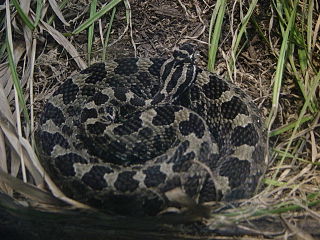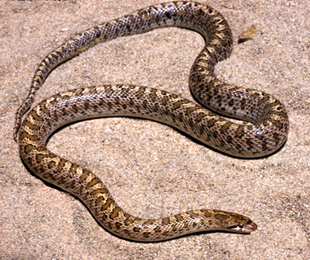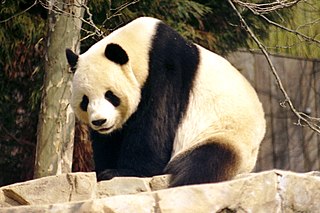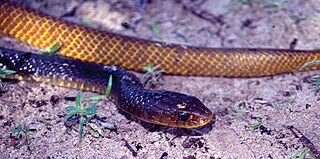
The milk snake or milksnake, is a species of kingsnake; 24 subspecies are currently recognized. Lampropeltis elapsoides, the scarlet kingsnake, was formerly classified as a 25th subspecies, but is now recognized as a distinct species. The subspecies have strikingly different appearances, and many of them have their own common names. Some authorities suggest that this species could be split into several separate species. They are not venomous to humans.

Kingsnakes are colubrid New World members of the genus Lampropeltis, which includes 26 species. Among these, about 45 subspecies are recognized. They are nonvenomous and ophiophagous in diet.

Antaresia is a genus of pythons, nonvenomous snakes in the family Pythonidae. The genus is native to Australasia. The genus is known by the common name Children's pythons, the name of the type species, Antaresia childreni. Gray named A. childreni in honour of his mentor, John George Children, who was a curator of the zoological collection at the British Museum around that time. It contains the smallest members of the Pythonidae. Four species and two subspecies are recognized, although they were all considered part of the same species until recently. A newly described form called the pygmy banded python may be a distinct species, but analysis has not yet been performed on this animal. The largest recorded examples of Antaresia species have all been males, suggesting males of the known species in this genus may compete for females. This behavior has never been witnessed in the wild, and has only been witnessed in captive specimens.

Morelia spilota, commonly known as the carpet python, is a large snake of the family Pythonidae found in Australia, New Guinea, Bismarck Archipelago, and the northern Solomon Islands. Many subspecies are recognised; ITIS lists six, the Reptile Database six, and the IUCN eight.

The tiger snake is a large and highly venomous snake of southern Australia, including its coastal islands and Tasmania. These snakes are often observed and locally well known by their banding, black and yellow like a tiger, although the species can be highly variable in coloration and patterning. All populations are classified within the genus Notechis (Elapidae). Their diverse characteristics have been classified either as distinct species or by subspecies and regional variation.

The eastern massasauga is a rattlesnake species found in central and eastern North America from southern Ontario in Canada and throughout the Midwestern and Eastern United States. Like all rattlesnakes, it is a pit viper and is venomous; it is the only species of venomous snake in Ontario.

The spotted python, eastern small-blotched python, or eastern Children's python is a python species found in northern Australia and New Guinea. It is a popular pet among Australian reptile enthusiasts and other reptile enthusiasts abroad due to its small size and even temperament. No subspecies were originally recognized. However, two subspecies were recognized as of 2020; A. m. maculosa and A. m. peninsularis.

Pituophis catenifer is a species of nonvenomous colubrid snake endemic to North America. Nine subspecies are currently recognized, including the nominotypical subspecies, Pituophis catenifer catenifer, described here. This snake is often mistaken for the prairie rattlesnake, but can be easily distinguished from a rattlesnake by the lack of black and white banding on its tail and by the shape of its head, which is narrower than a rattlesnake's.

Arizona elegans is a species of medium-sized colubrid snake commonly referred to as the glossy snake or the faded snake, which is endemic to the southwestern United States and Mexico. It has several subspecies. Some have recommended that A. elegans occidentalis be granted full species status.

Animals are multicellular eukaryotic organisms in the biological kingdom Animalia. With few exceptions, animals consume organic material, breathe oxygen, are able to move, reproduce sexually, and grow from a hollow sphere of cells, the blastula, during embryonic development. Over 1.5 million living animal species have been described—of which around 1 million are insects—but it has been estimated there are over 7 million in total. Animals range in size from 8.5 millionths of a metre to 33.6 metres (110 ft) long and have complex interactions with each other and their environments, forming intricate food webs. The study of animals is called zoology.

Opheodrys is a genus of small to medium-sized nonvenomous colubrid snakes commonly referred to as green snakes. In North America the genus consists of two distinct species. As their common names imply, the rough green snake has keeled dorsal scales, whereas the smooth green snake has smooth dorsal scales.

Crotalus willardi is a venomous pit viper species found in the southwestern United States and Mexico. This snake is found mainly in the "sky island" region. The IUCN reports this snake's conservation status as being of Least Concern. It is the official state reptile of Arizona.

Crotalus viridis is a venomous pit viper species native to the western United States, southwestern Canada, and northern Mexico. Currently, two subspecies are recognized, including the prairie rattlesnake, the nominate subspecies, and the Hopi rattlesnake.

The San Francisco garter snake is a slender multi-colored subspecies of the common garter snake. Designated as an endangered subspecies since the year 1967, it is endemic to San Mateo County and the extreme northern part of coastal Santa Cruz County in California.

Vipera ursinii is a species of venomous snake in the subfamily Viperinae of the family Viperidae. It is a very rare species, which is in danger of extinction. This species is commonly called the meadow viper. It is found in France, Italy, and Greece as well as much of eastern Europe. Several subspecies are recognized. Beyond the highly threatened European population, poorly known populations exist as far to the east as Kazakhstan and northwestern China.

Crotalus stejnegeri, commonly known as the Sinaloan long-tailed rattlesnake or just long-tailed rattlesnake, is a venomous pit viper species in the family Viperidae. The species is native to western Mexico. There are no recognized subspecies.

Trimeresurus flavomaculatus is a venomous pit viper species endemic to the Philippines. Two subspecies are currently recognized, including the nominate subspecies described here.

Agkistrodon contortrix mokasen was formerly a venomous pit viper subspecies found in the eastern United States. However, recent taxonomic changes do not recognize the northern copperhead as a valid taxon.

The indigo snake, also known as the yellow-tail cribo, is a species of snake in the family Colubridae. This large colubrid snake is nonvenomous.
William Roy "Bill" Branch was a British-South-African herpetologist.